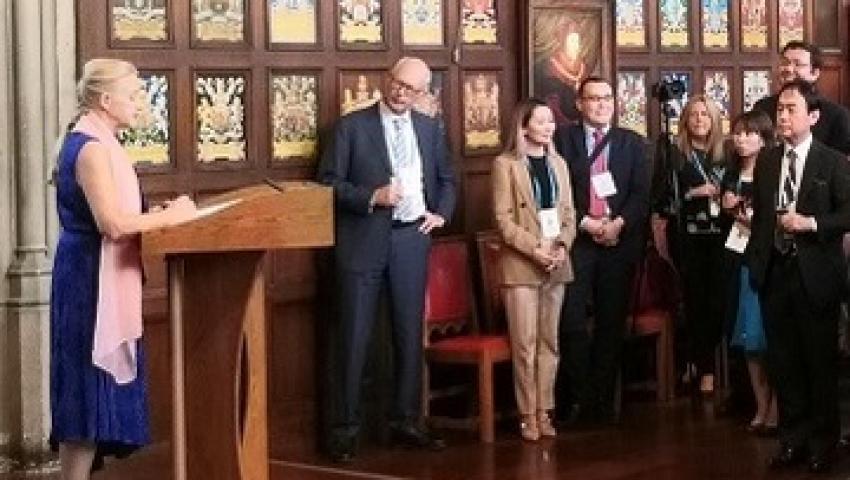Projections for nuclear generation capacity revised upwards in The Nuclear Fuel Report

World Nuclear Association’s projections for nuclear generating capacity growth have been revised upwards for the first time in eight years, following the introduction of more favourable policies in a number of countries.
In France, the country’s energy policy has been modified, delaying the planned reduction of nuclear power in the share of its electricity mix and allowing operating lifetime extensions of existing reactors beyond 40 years. In the USA, state legislatures are starting to pass measures that support the continued operation of reactors, recognizing the valuable role of nuclear in providing low-carbon electricity. At the same time, the process of granting a second operating licence extension for US nuclear reactors has begun, allowing reactors to operate for 80 years.
Both China and India have extensive nuclear expansion programmes and the prospects for new reactors in many countries have improved with several newcomer countries such as Turkey, Bangladesh and Egypt launching construction projects and several more, including Uzbekistan, Kazakhstan and Poland, demonstrating a clear interest in developing nuclear programmes.
The Upper and Reference Scenarios show global nuclear power capacities growing over the period to 2040 at a faster rate than at any time since 1990, increasing mainly due to extensive reactor building programmes in China, India and other countries in Asia. While projected growth in the Reference Scenario is moderate, with capacity growing to 569 GWe by 2040, in the Upper Scenario the present level of nuclear capacity is expected to almost double to 776 GWe. For the Lower Scenario, nuclear capacity essentially maintains its current level over the forecast period at 402 GWe.
Commenting on the publication of The Nuclear Fuel Report, Director General Agneta Rising said, "Achieving the Harmony goal of supplying 25% of the world's electricity before 2050 will require a rapid ramp-up of new nuclear build, higher than projected in the Upper Scenario, which in turn would lead to the need of greater amounts of uranium, enrichment, fuel fabrication, transport and used fuel services. Nuclear fuel cycle participants should be prepared to meet a potential large increase in demand to meet the Harmony goal."
The global nuclear industry’s Harmony goal aims to achieve a 25% share of nuclear power in world electricity supply before 2050, to support the world in keeping global temperature increases well below 2 °C.
The uranium market has been characterized by oversupply in recent years, which has led to a sizable reduction in uranium production levels at existing mines and a sharp decrease in investment in the development of new and existing mines. The three scenarios of uranium supply show that the capacity of all presently-known mining projects (current and idled mines, projects under development, planned or prospective) should be at least doubled by the end of the forecast period, and the need for new primary uranium supply becomes even more pressing as a number of older mines are projected to be depleted in the second decade. There are more than adequate uranium resources to meet future needs; however, oversupply and associated low uranium prices are preventing the investment needed to convert these resources into production. Uranium resources would be unlikely to be a limiting factor for the expansion of nuclear programmes in order to meet the Harmony goal..
The relative contribution of secondary supply to overall uranium supply will gradually diminish. However, a major component of secondary supply, commercial inventories, are playing an increasingly important role in the market, as many participants try to benefit from the current low prices of uranium and enrichment, increasing their stockpiles. Thus it is expected that in the short- or medium-term potential supply gap or shortfall may be covered by commercial inventories.
The conversion sector now shows undersupply with 9,500tU of conversion capacity being currently idled. However, it is expected that additional capacity will be required before 2030 because of strong demand growth.
Within the enrichment sector, production capacities appear to be sufficient to cope with requirements. Because centrifuge capacity is essentially modular in character, it would be easily adjusted according to increased demand.
The fuel fabrication sector is traditionally characterized by a high level of competition among different vendors, which is expected to ever more intensify with nuclear fuel demand increasing in Asia while decreasing in the West. This could potentially lead to a changing of the fuel fabrication supply picture, as fuel vendors are likely to shift from a current regional approach to a global market approach, which may result in a more balanced supply-demand equilibrium, increased competition and enhanced security of supply.
In the long-term perspective from around 2040, the development of Generation IV reactors could result in mass deployment of new types of reactor, which could bring fundamental changes to the nuclear fuel landscape. It is clear that Generation IV reactors offer the prospect of much more efficient use of a variety of secondary supply sources. In particular, closing the nuclear fuel cycle could become possible as ‘burners’ reactor designs may provide a option for the substantial quantities of used nuclear fuel, plutonium and depleted uranium stockpiles.
The Nuclear Fuel Report is available from our shop.
